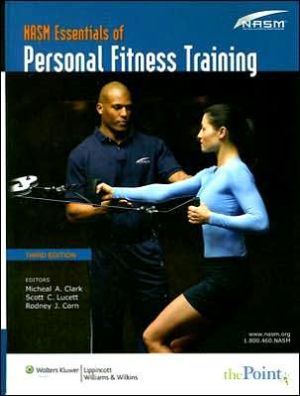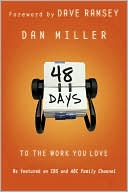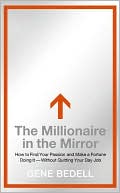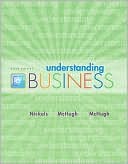NASM Essentials of Personal Fitness Training
Developed by the National Academy of Sports Medicine (NASM), this book is designed to help people prepare for the NASM Certified Personal Trainer (CPT) Certification exam or learn the basic principles of personal training using NASM's Optimum Performance Training (OPT) model. The OPT model presents NASM's protocols for building stabilization, strength, and power.\ More than 600 full-color illustrations and photographs demonstrate concepts and techniques. Exercise color coding maps each...
Search in google:
Developed by the National Academy of Sports Medicine (NASM), this book is designed to help people prepare for the NASM Certified Personal Trainer (CPT) Certification exam or learn the basic principles of personal training using NASM's Optimum Performance Training (OPT) model. The OPT model presents NASM's protocols for building stabilization, strength, and power.More than 600 full-color illustrations and photographs demonstrate concepts and techniques. Exercise color coding maps each exercise movement to a specific phase on the OPT model. Exercise boxes demonstrate core exercises and detail the necessary preparation and movement. Other features include research notes, memory joggers, safety tips, and review questions. Doody Review Services Reviewer:John M Kaltenborn, MS, ATC, PES(James Madison University)Description:This is the third edition of a book that covers the concepts of personal fitness training as well as the design and implementation of individualized training programs based on the guidelines of the National Academy of Sports Medicine (NASM). The second edition was published in July 2004.Purpose:The purpose is to provide a basis and guidelines for NASM certified personal trainers to design individualized, goal oriented, and very specific fitness programs for their clients. The programs designed by the fitness trainer will enable clients to obtain fitness goals while addressing any physical ailments/issues the clients may have, as well as not creating new ones. The book is used as the text for certification of all personal trainers by the NASM. Audience:Those interested in beginning a career in the fitness industry, those who have been working in the fitness industry for years, and those who have some understanding of personal fitness training are the intended audience. The authors have assumed that readers will have some basic knowledge of anatomy and physiology, exercise physiology, and strength training. Features:The book covers all aspects of the NASM personal fitness training program. The authors discuss in detail the foundations of their program, specifically Optimum Performance Training (OPT), and how it is of benefit to a personal training client. The book has excellent pictures, graphs, glossary, and diagrams. New to this edition are the "Memory Jogger" and "Stretch Your Knowledge" sections in each chapter. These new features allow readers to delve further into the topics and help to reinforce key concepts. Due to the nature of the information, some areas lack detail and gloss over information in an attempt to provide just enough background. Examples of this can be seen in the explanation of the ATP-CP cycle and in the anatomy section. The program design section could have been more detailed since this is one of the most important components of the certification. Manipulation of a program to meet various goals, including time constraints, needs to be better addressed. Some of these shortcomings are inherent in this type of book, which is designed for a multitude of readers. Assessment:This book does an excellent job of explaining the concepts of the NASM personal fitness training regimen. It is similar to others used by accrediting organizations in the way it presents information in the way the organization wants it presented. The new edition greatly simplifies the OPT model, a huge step toward making this information more digestible for those not immersed in the fitness industry. Overall, this is a welcome and well written update.
Code of EthicsPreface: Letter from the President of NASM AcknowledgementsUser's GuideFigure Credits List Part I: FUNDAMENTALS OF HUMAN MOVEMENT SCIENCE Chapter 1:The Scientific Rationale for Integrated Training Chapter 2:Basic Exercise Science Chapter 3: The Cardiorespiratory System Chapter 4:Human Movement Science PART II: ASSESSMENTS, TRAINING CONCEPTS,AND PROGRAM DESIGN Chapter 5:Fitness Assessment Chapter 6:Flexibility Training Concepts Chapter 7:Cardiorespiratory Training Concepts Chapter 8:Core-Training Concepts Chapter 9:Balance-Training Concepts Chapter 10:Reactive (Power) Training Concepts Chapter 11:Speed, Agility, and Quickness Chapter 12:Resistance-Training Concepts Chapter 13:Program Design Concepts Chapter 14:Special Populations PART III: NUTRITION AND SUPPLEMENTATION Chapter 15:Nutrition Chapter 16:Supplementation PART IV: CLIENT INTERACTION AND PROFESSIONAL DEVELOPMENT Chapter 17:Behavior Modification Chapter 18:Professional Development GlossaryAppendicesAnswer KeyIndex
\ From The CriticsReviewer: John M Kaltenborn, MS, ATC, PES(James Madison University)\ Description: This is the third edition of a book that covers the concepts of personal fitness training as well as the design and implementation of individualized training programs based on the guidelines of the National Academy of Sports Medicine (NASM). The second edition was published in July 2004.\ Purpose: The purpose is to provide a basis and guidelines for NASM certified personal trainers to design individualized, goal oriented, and very specific fitness programs for their clients. The programs designed by the fitness trainer will enable clients to obtain fitness goals while addressing any physical ailments/issues the clients may have, as well as not creating new ones. The book is used as the text for certification of all personal trainers by the NASM. \ Audience: Those interested in beginning a career in the fitness industry, those who have been working in the fitness industry for years, and those who have some understanding of personal fitness training are the intended audience. The authors have assumed that readers will have some basic knowledge of anatomy and physiology, exercise physiology, and strength training. \ Features: The book covers all aspects of the NASM personal fitness training program. The authors discuss in detail the foundations of their program, specifically Optimum Performance Training (OPT), and how it is of benefit to a personal training client. The book has excellent pictures, graphs, glossary, and diagrams. New to this edition are the "Memory Jogger" and "Stretch Your Knowledge" sections in each chapter. These new features allow readers to delve further into the topics and help to reinforce key concepts. Due to the nature of the information, some areas lack detail and gloss over information in an attempt to provide just enough background. Examples of this can be seen in the explanation of the ATP-CP cycle and in the anatomy section. The program design section could have been more detailed since this is one of the most important components of the certification. Manipulation of a program to meet various goals, including time constraints, needs to be better addressed. Some of these shortcomings are inherent in this type of book, which is designed for a multitude of readers. \ Assessment: This book does an excellent job of explaining the concepts of the NASM personal fitness training regimen. It is similar to others used by accrediting organizations in the way it presents information in the way the organization wants it presented. The new edition greatly simplifies the OPT model, a huge step toward making this information more digestible for those not immersed in the fitness industry. Overall, this is a welcome and well written update.\ \







